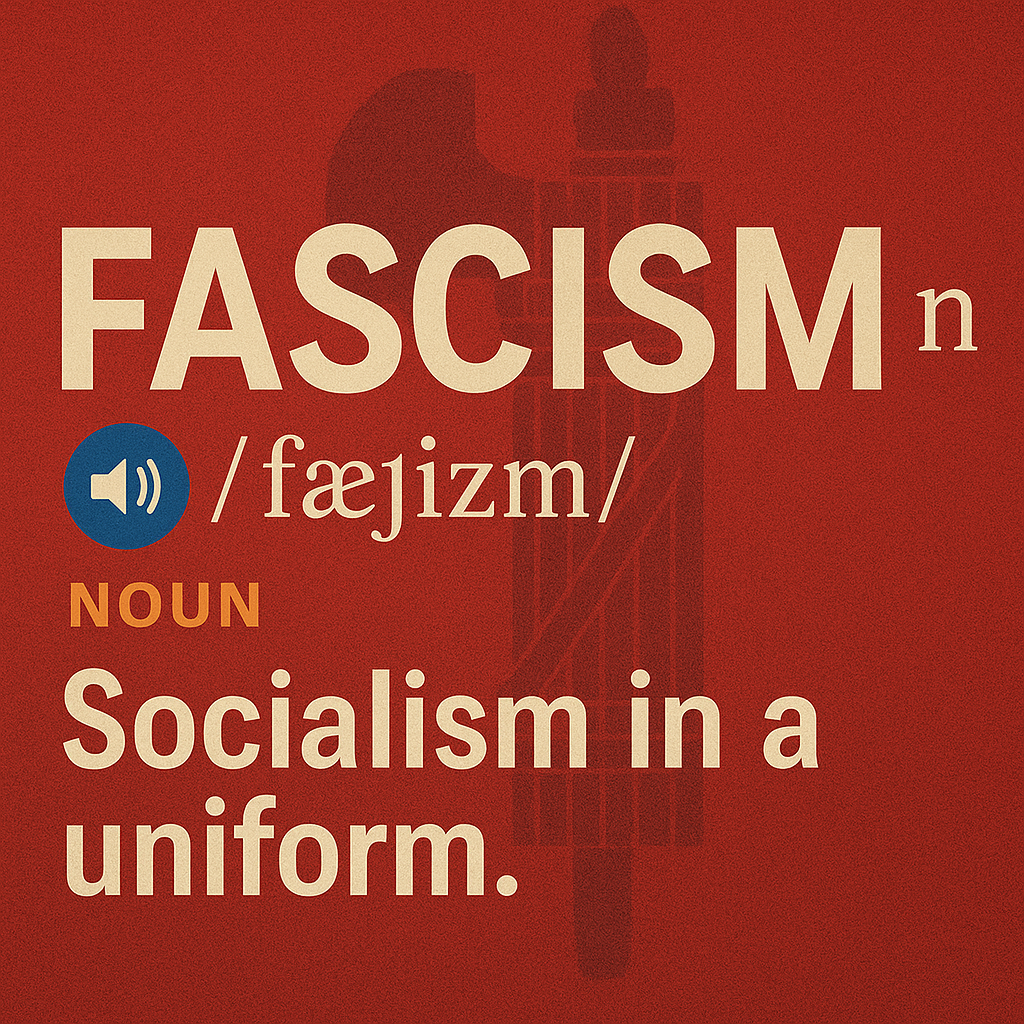Title:
By John Fisher
In the age of moral gaslighting, few lies have done more cultural damage than the idea that fascism belongs on the “far right.” That myth is repeated like gospel in classrooms and on cable news, yet it couldn’t be further from the truth. Strip away the pageantry, the salutes, and the boots, and what’s left is not some unique political philosophy. Fascism, at its core, is just socialism with better tailoring.
To understand fascism is to return to its roots—not the strawmen conjured up by modern propagandists, but the actual ideological soil from which it sprang. Benito Mussolini didn’t just stumble into power with a vague sense of nationalism. He was a lifelong socialist. He edited Avanti!, the official newspaper of the Italian Socialist Party, and for years preached class revolution and state control with all the fervor of a Marxist priest. His eventual split from the party wasn’t over principle—it was over strategy. He believed Marxists were too slow, too theoretical. He wanted action.
So he created a new costume for the same old play.
Enter Giovanni Gentile: The Philosopher of the State
Every revolution has its theorist. For Marx, it was Hegel. For Mussolini, it was Giovanni Gentile—a philosopher so drunk on the power of the collective that he made Karl Marx look like a rugged individualist. Gentile’s idea, called “actual idealism,” placed the state at the center of all reality. There was no truth outside the state. No morality apart from its decree. No individual worth that could not be folded into the collective will.
Gentile didn’t hide this. He declared the purpose of fascism openly: “The State is not simply the guardian of law… it is the source of law, the creator of right.” In other words, you have no rights unless the State gives them to you—and it can take them away just as easily.
Sound familiar?
It should. That’s not conservatism. That’s not liberalism. That’s Marxism with a nationalistic paint job. It’s the same contempt for the individual. The same worship of centralized power. The same belief that you exist not for your own purpose, but to serve a grand, state-directed design.
The Fasces: A Symbol of Submission
Even the symbol of fascism betrays its collectivist core. The fasces—an axe bound by a bundle of sticks—was borrowed from ancient Rome. One stick alone is weak. Many sticks bound together are strong. That might sound noble, until you realize what’s missing: the person.
There’s no room for dissent in that bundle. No room for individual thought, conscience, or liberty. The entire point of the symbol is submission to unity, even when unity is wrong. It’s the visual opposite of Americanism, where the rights of the individual are sovereign, even when the crowd disapproves.
And just like Marxism, fascism couldn’t tolerate opposition. It controlled speech. It centralized industry. It declared war on the free press, on the church, and on any institution that dared to claim a higher moral order than the State. In Mussolini’s Italy, as in Stalin’s Russia, there was only one acceptable belief: obedience.
Economic Fascism: Socialism by Another Name
Critics will say, “But fascism wasn’t purely socialist. It allowed private property.” Only if you believe property is still private after the State tells you how to use it, what to produce, how much to charge, and where your profits must go. Fascism didn’t abolish corporations. It simply nationalized their purpose. Businesses still existed, but only as arms of the State. You were allowed to own a factory—but only if your factory served the regime.
This wasn’t free-market capitalism. This was command economics—central planning with a capitalist mask. Mussolini himself said: “All within the state, nothing outside the state, nothing against the state.” That’s not a description of the right wing. That’s the very definition of collectivism.
The Myth of Right-Wing Fascism
So how did fascism get pinned on the right? Simple. The left needed a scapegoat.
After World War II, as the atrocities of both Nazism and fascism came to light, Marxists across Europe and America realized they had a branding problem. Too many of their ideological cousins had blood on their hands. So they did what any good propagandist would do: they rewrote the story.
They started labeling anything they didn’t like as “right-wing.” National pride? Right-wing. Traditional values? Right-wing. Resistance to collectivism? Right-wing. It didn’t matter that the Nazis called themselves National Socialists, or that Mussolini was a card-carrying Marxist who rebranded socialism as nationalism. The narrative had changed. And in politics, perception is everything.
Individualism Is the Antidote
Here’s the truth the left wants you to forget: Fascism and Marxism are twin ideologies. One preaches international revolution, the other national unity. But both destroy the individual. Both reject the idea of unalienable rights. Both elevate the collective above the conscience. And both rely on coercion, censorship, and state power to achieve their ends.
That is why the American idea is their enemy. Because Americanism begins with the premise that you are not a stick in a bundle. You are a soul. You are endowed by your Creator—not your government—with rights that no regime can take away. You are free to speak, to build, to believe, and to dissent.
That’s why they hate it.
That’s why they lie.
That’s why they keep calling fascism a “right-wing” ideology—because if you ever realize that fascism is simply another flavor of leftist tyranny, you might start asking what else they’ve lied about.
And you might start pushing back.
Citations:
- Gentile, Giovanni. Origins and Doctrine of Fascism, 1929.
- Mussolini, Benito. The Doctrine of Fascism, 1932.
- Payne, Stanley G. A History of Fascism, 1914–1945. University of Wisconsin Press, 1995.
- Griffin, Roger. The Nature of Fascism, Routledge, 1991.
- Pipes, Richard. Communism: A History, Random House, 2001.



